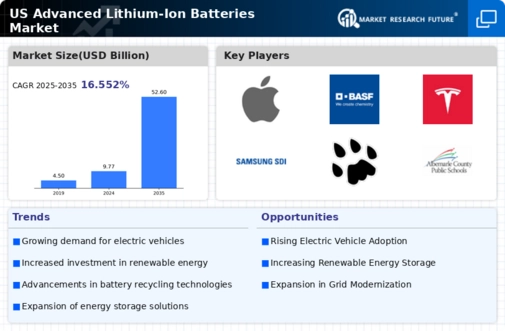Growing Demand for Electric Vehicles
The increasing adoption of electric vehicles (EVs) is a primary driver for the advanced lithium-ion-batteries market. As consumers and manufacturers prioritize sustainability, the demand for EVs is projected to rise significantly. In 2025, the EV market in the US is expected to grow by approximately 30%, leading to a corresponding increase in the need for advanced lithium-ion batteries. This surge is driven by advancements in battery technology, which enhance vehicle range and performance. Furthermore, major automotive manufacturers are investing heavily in battery production, indicating a robust future for the advanced lithium-ion-batteries market. The shift towards electric mobility not only supports environmental goals but also stimulates economic growth within the sector.
Increased Investment in Renewable Energy
The transition towards renewable energy sources is fostering growth in the advanced lithium-ion-batteries market. As the US aims to reduce its carbon footprint, investments in solar and wind energy are on the rise. Energy storage solutions, particularly advanced lithium-ion batteries, are essential for managing the intermittent nature of renewable energy. In 2025, the energy storage market is anticipated to reach $10 billion, with a significant portion attributed to advanced lithium-ion technologies. This trend indicates a growing recognition of the importance of energy storage in achieving energy independence and sustainability goals. Consequently, the advanced lithium-ion-batteries market is likely to benefit from this increased focus on renewable energy integration.
Technological Innovations in Battery Chemistry
Innovations in battery chemistry are propelling advancements in the lithium-ion-batteries market. Research and development efforts are yielding new materials and designs that enhance battery performance, longevity, and safety. For instance, the introduction of solid-state batteries is expected to revolutionize the market by offering higher energy densities and faster charging times. As of 2025, the market for solid-state batteries is projected to grow at a CAGR of 25%, indicating a strong shift towards these advanced technologies. This evolution in battery chemistry not only improves the efficiency of energy storage but also expands the applications of advanced lithium-ion batteries across various sectors, including consumer electronics and grid storage.
Government Incentives for Clean Energy Technologies
Government incentives play a crucial role in shaping the advanced lithium-ion-batteries market. Various federal and state programs are designed to promote the adoption of clean energy technologies, including tax credits and grants for battery manufacturers and consumers. In 2025, it is estimated that these incentives could lead to a 15% increase in the adoption of advanced lithium-ion batteries in residential and commercial applications. Such support not only lowers the financial barriers for consumers but also encourages manufacturers to innovate and expand their production capabilities. The alignment of government policies with market needs is likely to create a favorable environment for the growth of the advanced lithium-ion-batteries market.
Rising Consumer Awareness of Energy Storage Solutions
Consumer awareness regarding energy storage solutions is steadily increasing, driving demand for advanced lithium-ion batteries. As individuals and businesses seek to optimize energy usage and reduce costs, the appeal of energy storage systems becomes more pronounced. In 2025, it is projected that the residential energy storage market will grow by 20%, largely due to heightened consumer education and marketing efforts. This trend suggests that consumers are becoming more informed about the benefits of energy storage, including backup power and energy cost savings. Consequently, the advanced lithium-ion-batteries market is likely to experience a surge in demand as consumers increasingly recognize the value of these technologies in their daily lives.

























Leave a Comment